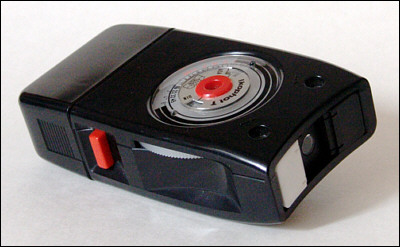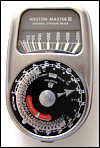Zeiss Ikon Ikophot T

For some time, I've been looking for an everyday light meter -- one that is durable and accurate. I wanted a meter that is easy to use, reliable and doesn't cost more than my camera.
If you use a lot of classic cameras, you need a good light meter. I have used some of the selenium meters, including a number of Westons and Ikophots. For "serious" work, I have a digital Sekonic.
One of the great things about the Westons is that they're plentiful and for the most part still accurate. One of the bad things about the Westons is that the needle often can be knocked out of kilter. And beyond that, the dials on the earlier models are filled with tiny numbers. Really tiny numbers.
The postwar selenium Ikophots are very usable with numbers just for aperture and shutter speed. The main problem was finding one that still worked. It's been my experience that the Ikophots seemed to be much more prone to being sluggish or inaccurate than the Westons. When they work, they're wonderful. But when they don't, you might as well be carrying a small rock in your camera bag.
The Ikophot T is the last of the Zeiss Ikon light meters. No needle, just three glow bulbs and a dial. By the way, these might look like LEDs, but they're not. It uses a common 9-volt radio battery. Because there is no needle, the mechanism is more durable. The meter seems to be very responsive.
My meter is black, and there was a later version that is ivory with a chocolate brown battery cover. How do I know this is a later version? Because it's branded as Zeiss-Ikon/Voigtlander, while this one is branded Zeiss Ikon.
Like the earlier Ikophots, the Ikophot T can do incident or reflective metering.

How do you use the Ikophot T? Like many European products, there is beauty is its simplicity. There is a red button on either side of the meter. On the top of the meter, there is the exposure dial and two recessed white bulbs. On the front of the meter is the cell, there are two flaps -- one white and the other black. For reflective reading, make sure that neither flap is covering the meter cell. Flip the small hinged white flap over the meter cell for incident readings.
The small black flap appears to be a protective cover for the meter cell.
Set your film speed by twisting the two nubs that protrude from the middle of the exposure dial.
You can hold the meter in either hand. Press one of the red buttons and one of the bulbs will light up. Use your thumb to turn the serrated edge of the exposure dial in the direction of the lit arrow. When you have the correct exposure, the bulbs will go out and the dial will light up. This is design brilliance, because it helps you read the exposure setting in dim light and also cues you to the fact that you now have the correct reading. The light is visible in daylight, as well.
There is a small zippered case for it, but I've stowed it in favor of a slightly larger Crumpler accessory case, which I keep attached to the straps of my backpack.
Battery life is excellent. I've switched batteries once in three years.
I've found the Ikophot T to be easy to use and accurate, and that's the most important part. If a meter isn't accurate -- no matter how simple it is to use -- then it's useless.
